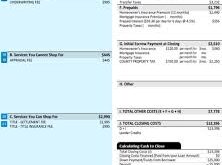Mortgage Loan Terms: Need to Know Before Borrowing. When purchasing a home, one of the most important financial decisions you’ll make is securing a mortgage loan. However, understanding mortgage loan terms is crucial to ensuring you get the best deal and avoid costly mistakes. In this guide, we’ll break down essential mortgage loan terms, how they impact your loan, and what to consider before signing any agreement.
Key Mortgage Loan Terms Explained
1. Principal
The principal is the amount you borrow from the lender to purchase your home. This amount does not include interest, fees, or any other charges.
2. Interest Rate
The interest rate is the cost you pay to borrow money, expressed as a percentage. Mortgage interest rates can be fixed (remain the same throughout the loan term) or variable (change based on market conditions).
3. Annual Percentage Rate (APR)
The APR includes the interest rate and other loan-related fees, giving a more comprehensive view of the loan’s total cost.
4. Loan Term
The loan term is the length of time you have to repay the mortgage, commonly ranging from 15 to 30 years.
5. Fixed-Rate vs. Adjustable-Rate Mortgage (ARM)
- Fixed-Rate Mortgage: The interest rate remains constant for the entire loan term.
- Adjustable-Rate Mortgage (ARM): The interest rate may change periodically based on market conditions.
6. Down Payment
The initial upfront payment made toward purchasing a home, typically ranging from 3% to 20% of the home’s price.
7. Loan-to-Value Ratio (LTV)
LTV compares the loan amount to the property’s value. A lower LTV usually results in better loan terms and lower interest rates.
8. Private Mortgage Insurance (PMI)
If your down payment is less than 20%, lenders often require PMI to protect against potential default.
9. Escrow Account
An escrow account holds funds for property taxes and homeowners insurance, ensuring timely payments.
10. Closing Costs
Closing costs include fees for loan origination, appraisal, title insurance, and other expenses associated with finalizing the mortgage.
How Mortgage Loan Terms Affect Your Borrowing Power
Understanding mortgage loan terms helps you determine how much you can afford. Here’s how different terms impact your loan:
- Interest Rate: A higher interest rate increases your monthly payments, while a lower rate reduces overall borrowing costs.
- Loan Term: A shorter term means higher monthly payments but lower total interest paid over the life of the loan.
- Down Payment: A larger down payment can eliminate the need for PMI and result in better loan terms.
- Credit Score: A higher credit score improves your chances of securing favorable interest rates.
10 Essential Tips for Mortgage Borrowers
- Improve Your Credit Score – A high credit score qualifies you for better rates.
- Compare Multiple Lenders – Shop around for the best mortgage rates and terms.
- Understand Your Loan Type – Choose between fixed-rate and adjustable-rate based on your financial situation.
- Consider the Loan Term – A 15-year mortgage reduces interest payments but requires higher monthly payments.
- Save for a Larger Down Payment – A higher down payment can lower costs and remove PMI requirements.
- Check Loan Fees – Watch out for hidden fees in your mortgage agreement.
- Understand Prepayment Penalties – Some loans charge a fee for early repayment.
- Use a Mortgage Calculator – Estimate your monthly payments before committing.
- Get Pre-Approved – A pre-approval strengthens your buying position.
- Read the Fine Print – Ensure you fully understand all terms before signing.
10 Common FAQs About Mortgage Loan Terms
1. What is the best mortgage loan term?
It depends on your financial goals. A 15-year mortgage saves interest, while a 30-year mortgage lowers monthly payments.
2. How does my credit score affect my mortgage?
Higher credit scores qualify for lower interest rates and better loan terms.
3. Can I change my mortgage loan terms later?
Yes, refinancing allows you to modify your loan’s interest rate or term.
4. What happens if I miss a mortgage payment?
Missing payments can lead to penalties, increased interest, and potential foreclosure.
5. How much should I put down on a home?
A down payment of at least 20% is ideal to avoid PMI and secure better rates.
6. Is an ARM better than a fixed-rate mortgage?
ARMs may offer lower initial rates, but fixed-rate mortgages provide long-term stability.
7. What are closing costs, and how much are they?
Closing costs range from 2% to 5% of the home’s price and cover fees related to finalizing the mortgage.
8. What is an escrow account?
An escrow account manages property tax and insurance payments.
9. What is the difference between APR and interest rate?
APR includes the interest rate plus additional fees, providing a clearer total loan cost.
10. Can I pay off my mortgage early?
Yes, but check for prepayment penalties that may apply.
Conclusion
Understanding mortgage loan terms is essential for making informed financial decisions when purchasing a home. By familiarizing yourself with key terms like interest rates, loan terms, down payments, and fees, you can confidently navigate the mortgage process. Whether you’re a first-time homebuyer or refinancing an existing loan, knowing these terms will help you secure the best possible mortgage for your needs.
To ensure you get the best deal, compare lenders, improve your credit score, and read the fine print carefully. A well-planned mortgage strategy can save you thousands of dollars and provide financial security for years to come.
 mortgage.kbk.news
mortgage.kbk.news
